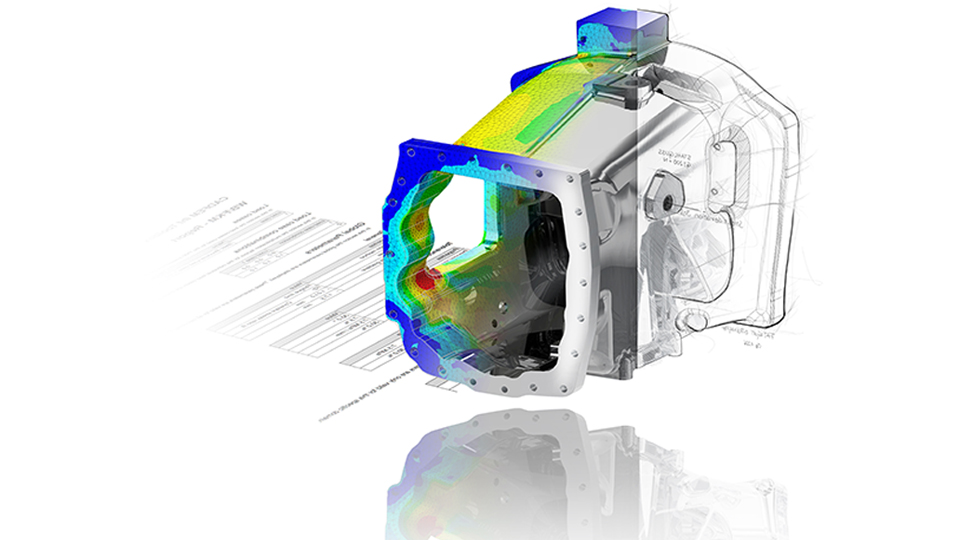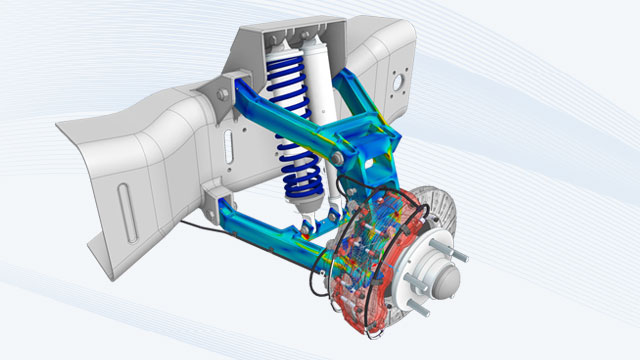How Soft Mobility Benefits from Simulation-Driven-Development
Push the Innovation Pedal with Simulation Technology
The rapid advancements in bicycle engineering and design can be greatly attributed to novel approaches in the product development process such as computational modeling and the use of simulation tools in the early stages. Also known by the term “simulation-driven engineering”, these methods play a critical role at Radiate Engineering & Design, where engineers and designers are enhancing the design, performance, and safety of future bicycle systems.
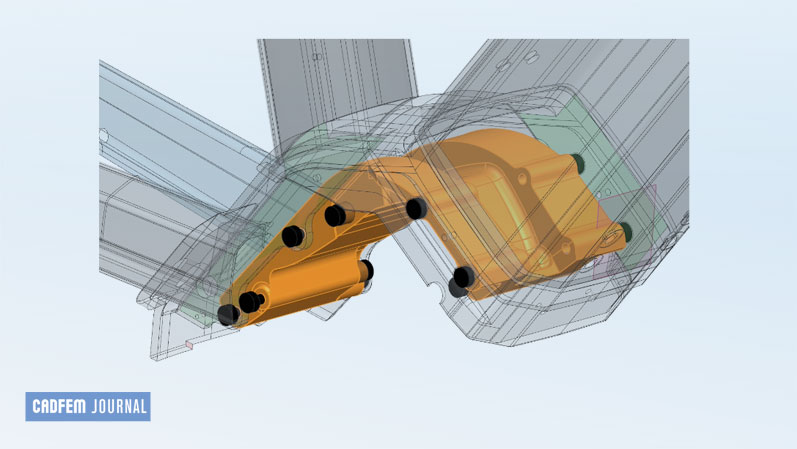
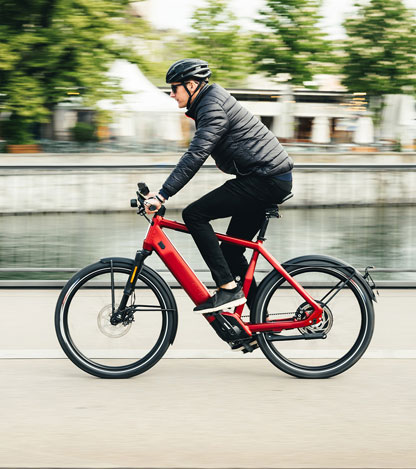
Just across the new and imposing Police and Justice Centre in Zurich, painted in gray anthracite, a remnant of Zurich’s industrial past still stands. In this building, filled with abundant industrial charm, passionate work is being done on shaping the future of cycling and urban mobility. At Radiate Engineering & Design, ideas are conceived that go far beyond ordinary tinkering. In their laboratory, innovative concepts are developed, engineered, calculated, tested, and transitioned into products that can be industrialized. Early on, Radiate relied on integrating simulation technologies into the development process, which proved to be a true milestone. The use of advanced engineering tools and technologies allow for a significant time and cost reduction in the design process while simultaneously enhancing innovation and decreasing uncertainties - benefits that are well appreciated by clients of Radiate.
Challenges and solutions for a whole new category of e-bikes
Modern e-bikes go far beyond the functionality of a classic bicycle for recreational use. In fact, the category of e-bikes has seen an unprecedented diversification of models with different functionalities and use cases in recent years. The boundaries between bicycles and vehicles are becoming increasingly blurred. Think about S- Pedelecs (Speed Pedelecs) and Cargo Bikes for example, which thanks to technological advancements, are increasingly becoming alternatives to cars and other modes of transportation within the urban environment. These modern e-bikes pose new design challenges. There's a need to rethink design elements and structural requirements because the frames of these bikes are exposed to greater loads than traditional bikes.
Not only do frames and components need to support added weight, but they also need to handle the increased dynamic forces exerted during higher-speed rides and sudden stops as well as increased loads due to cargo transportation. The industry’s challenge lies not just in reimagining the design but also in ensuring that these designs adhere to safety and performance standards.
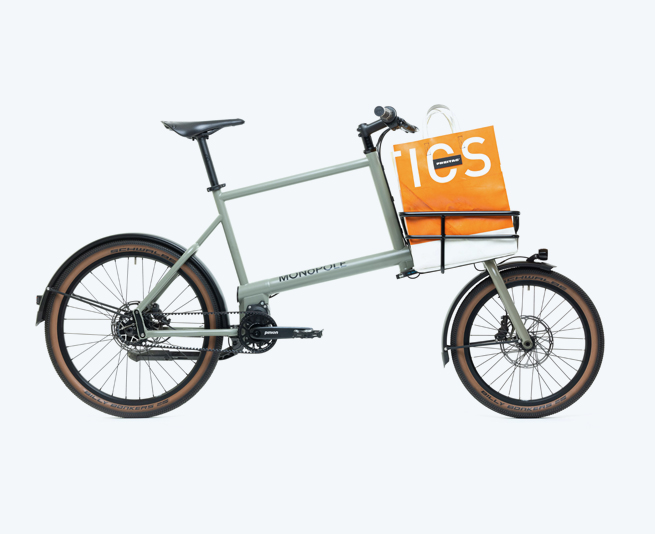
This is where existing standards, such as ISO 15194 and DIN 79010, seem to fall short. While they provide a foundation, they don't entirely encapsulate the nuances and intricacies required for the development of advanced e-bike systems. Engineers at Radiate are confronted with this situation and are faced with the challenge of implementing the wishes of end customers and manufacturers alike. How can this be accomplished?
Juan Navarro, Lead Bicycle EngineerAnsys Mechanical provides the tools to drive our CAE models parametrically, enabling quick iterations and effective fine-tuning of the finest details across all sizes of a bicycle frame.
Structural analysis running in parallel to the development
One example is the Speed Pedelec “OPIUM” from Swiss brand Revolt Zycling. The OPIUM is a high-performance long-range e-bike with a battery capacity of 1600Wh above 280 km range, a 930 W nominal power hub motor and a resulting top speed of 45 km/h. The brand OPIUM is promoted with the slogan “#Yournextcar”, which implies a very clear goal: to be part of the mobility transition offering typical commuters a fast, reliable, and environmentally friendly alternative to a car. The structural development of OPIUM was driven by time to market, reliability, and product robustness aspects. The entire project timeframe was extremely short, needing only a few months from the idea to the market launch. Such an ambitious time frame does not allow large prototype - test - improvement loops, but the first prototypes must already be at the highest stage of development in order to avoid time and cost intensive iterations with suppliers.
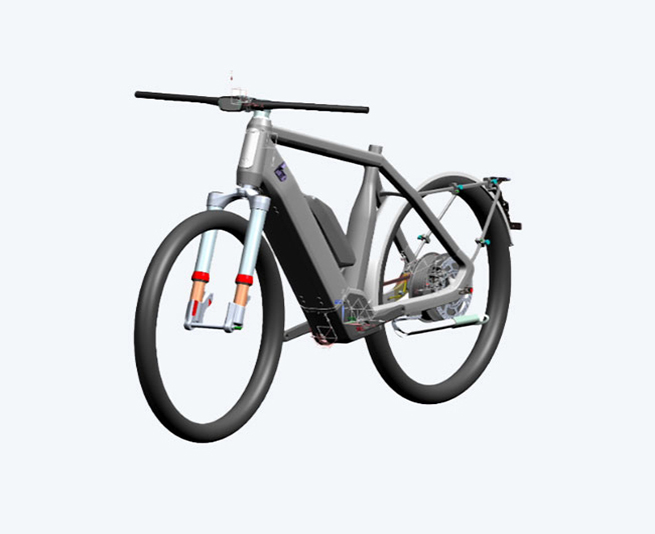
Thus, already in an extremely early concept phase of the project, a digital representation and a flexible 3D and simulation model was set up, in which all design concepts could be directly tested for their structural influence and feasibility. As the OPIUM was being developed, structural analyses of the frame and structural components (add-on parts) were conducted simultaneously. The findings and results were continuously incorporated into the development and optimization process.
The versatile ANSYS simulation environment makes it possible to easily implement the standard load cases and, in addition, specially defined design load cases to digitally represent the entire approval test cycle in advance. In this way, it was possible to ensure that even the first prototype frames passed the entire test series without any failure and intensive prototyping loops.
At the same time, not only are the structural requirements extremely important, but also the performance. So, how does the bike feel under riding conditions? How is the stiffness? Is it stiff enough, but still compliant enough and therefore comfortable? All these questions can be answered during development thanks to the flexible simulation environment that accompanies development.
For example, the structural integrity of the highly loaded gear shift mount under cycling fatigue loading is critical.
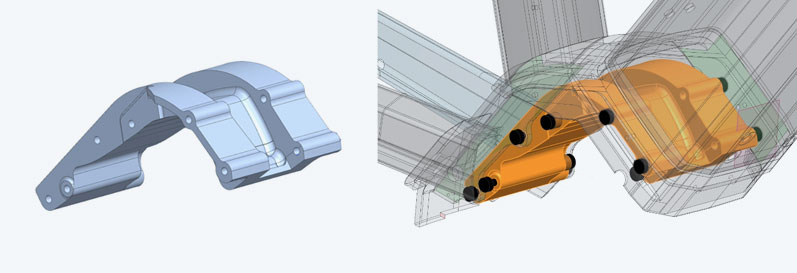
Using ANSYS Mechanical, a detailed design analysis of the component was performed with the goal of finding the optimal geometry that withstands all critical load cases and is compliant with the weight requirements of the component.
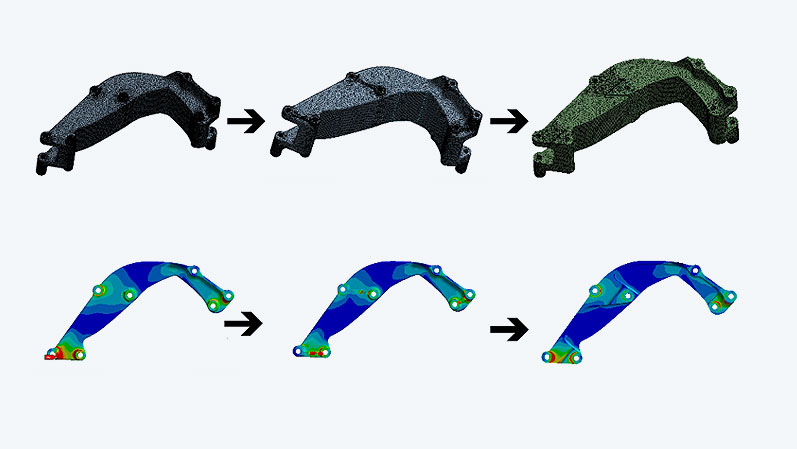
Jonas Schmid, Member of the Executive Board and Head of the Bike DivisionUsing the advanced structural simulation software from ANSYS, we can analyze and predict the performance of any bicycle component under a variety of scenarios. We can then adjust the design accordingly to enhance stability, durability, safety, and overall riding performance.
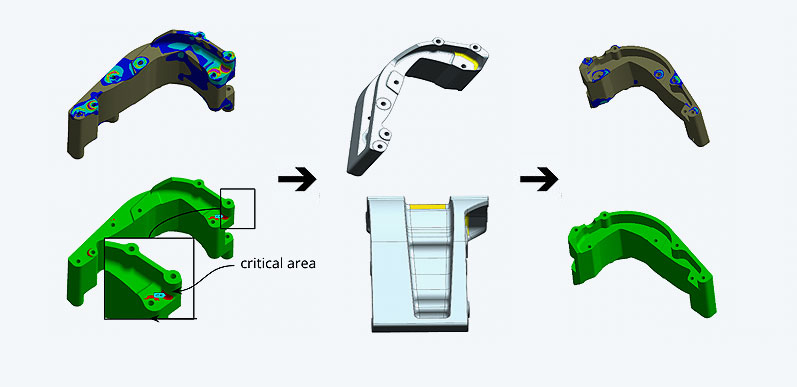
In order to be able to do this, a flexible development environment in which it is possible to iterate extremely quickly between the 3D model in CAD and the simulation environment is essential. This is ideally covered by the ANSYS Workbench Environment.
Parameter study for the definition of tube wall thicknesses
Another example in the category of compact cargo bikes is the “Toolbike No 01” by the Zurich-based brand MONoPOLE. Strikingly different, the E-cargo bike – developed in Switzerland and hand-welded and assembled in the French Pyrenees – aims to be more than just a tool for urban life.
When Radiate was approached by their client, the development of the product had already been advanced and 3D CAD data of the current frame concept as well as a first functional prototype had already existed. The MONoPOLE team however faced the challenge of structural improvements of the given geometry since the first prototypes didn’t perform as well as expected under extreme load. The bike lacked the smooth drive originally intended: a natural frequency of 17.6 Hz was measured for a prototype that vibrated while riding with a fully loaded cargo rack.
The engineers from Radiate set out to perform an analysis and take possible actions for optimization iterations in order to improve the structure. The goal was to improve riding performance and obtain a stiff frame while keeping the weight as low as possible. To do this, a parameter study was conducted, which calculated and tested various tube wall thickness variations against two critical load cases: Stand / Impact and BB cycling fatigue.
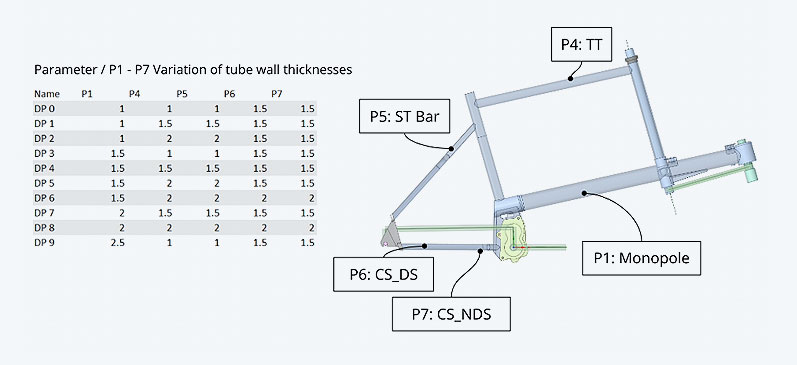
The analysis showed that the tube wall thickness could indeed be optimized. By slightly increasing the wall thicknesses of certain tubes by 0.5 mm, a +20% higher natural frequency and an overall stiffer frame could be achieved.
Timothy Habermacher, Member of the Executive BoardAt Radiate Engineering and Design, our collaboration with CADFEM and their sophisticated ANSYS software is pivotal. It empowers us to elevate the standards of bicycle development through rigorous CAE and FE-analyses, ensuring that our designs are not only cutting-edge but also meticulously engineered.
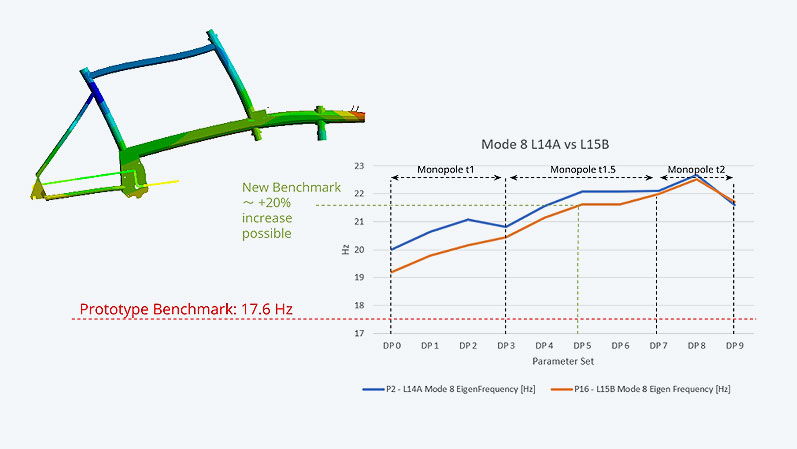
The thorough assessment of the main frame structure and the optimization iterations resulted in fast improvement cycles for the geometry and riding performance. The optimized Toolbike No 01 frame not only has a robust and durable structural integrity, but also feels smooth while riding it. Consequently, the innovative bike was awarded with the prestigious “Startup Award” at the recent EUROBIKE in June 2023.
Simulation drives Radiate Engineering & Design into the future
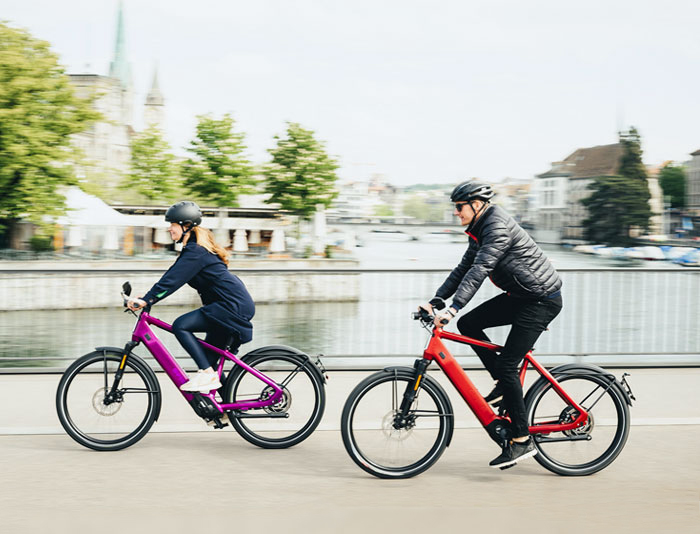
The forward momentum at Radiate Engineering & Design is unmistakable. Given the foundation that the company has laid through its integration of “simulation-driven engineering”, the team is poised for more transformative innovations in the realm of cycling and urban mobility in the upcoming years. By intertwining engineering prowess with simulation excellence, Radiate is set to redefine standards and expectations and push the boundaries of what’s possible in bicycle design.

Radiate Engineering und Design AG
Hohlstrasse 176
8004 Zurich
Author:
Frederic Poppenhäger
(Radiate Engineering & Design AG)
Cover Images:
Right: © Revolt Zycling AG
Left: © Radiate Engineering & Design AG
Published: November, 2023
Contact CADFEM



